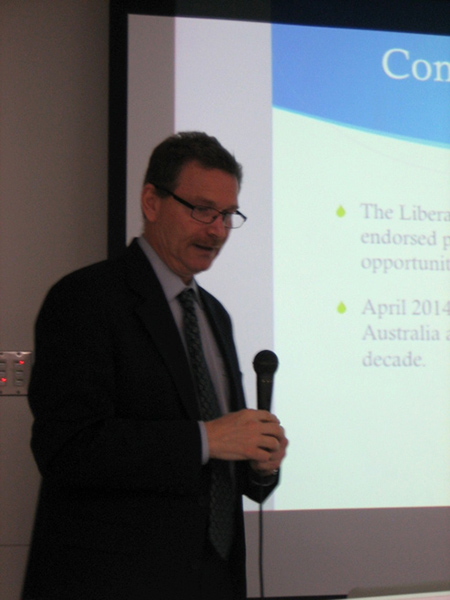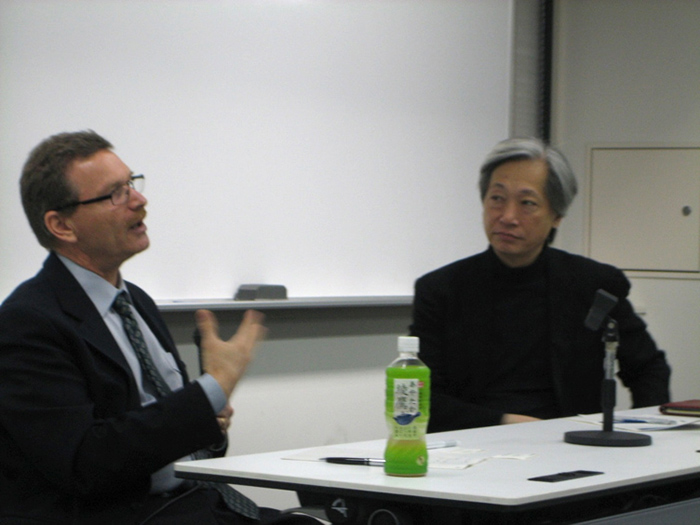SSU Forum with Professor David Walton
| Date: | Wednesday, November 5, 2014, 10:30-12:00 |
|---|---|
| Venue: | Kojima Conference Room, 2nd floor, Kojima Hall |
| Subject: | Juggling Triads: Australian foreign policy towards Japan and China |
| Lecture: | Dr. David Walton (Senior Lecturer, University of Western Sydney) |
| Language: | English |
| Hosted by: | Security Studies Unit, Policy Alternatives Research Institute, the University of Tokyo |
SSU Director Professor Kiichi Fujiwara introduced Dr. David Walton, Senior Lecturer at the University of Western Sydney and currently Visiting Researcher at the University of Tokyo, as the author of numerous contributions to the understanding of East Asian politics, with particular focus on the Australian perspective and Canberra’s strategy for the future, which constituted the topic of this SSU Forum.
Dr. Walton thanked Professor Fujiwara and started his presentation by providing a broad-stroke picture of the context in which Australia’s foreign policy is operating at the present time, and it will continue to operate, with all probability, in the foreseeable future, namely the context of East Asia power transition and the “rise of China”.

The ascent of China and its increasing economic hegemony in the region poses a number of security questions, which Canberra has so far addressed with a double strategy of balancing/hedging against Beijing on the one hand, but on the other of engagement and development of stable, strong economic and industrial relations.Dr. Walton has then illustrated different possible scenarios for the future of East Asia, which appears largely to be depending from the future of the US-China relations. Scholars have been working on the formulation of hypotheses for the most likely scenarios lying ahead, from a US disengagement, to China’s direct challenge of US dominance, to China’s piecemeal modification of the status quo without direct challenge, to finally the possibility of a stable balance of power being achieved.
He also referred to the recent model power transition theory articulated but Yves-Heng Lim, which pessimistically argues how China is highly dissatisfied with the existing regional arrangement, and sees a very dim prospect for a peaceful transition.
From an Australia perspective, the “rise of China” has had a profound impact on the country and its foreign policy. While Japan used to be the main trade partner, China-Australia trade volume is now more than double that of Japan-Australia trade, growing steadily in the past few years. This has also changed the orientation of Australian economy and the dynamics of economic lobbying at domestic level. In the general public, perceptions are mixed. While many Australians consider China to be an economic and possibly a military threat, many also sense and think that China will be the most important country to look to for the future of Australia, and the perception of China is generally positive and friendly.
The current Australian government under the leadership of PM Tony Abbott is continuing pre-existing policies of engagement, and seeks new opportunities to strengthen ties with Beijing. Australia sent to China in April of this year the largest delegation from a Western country in a decade. Canberra’s foreign policy objectives have been traditionally based on two intertwined threads, namely securing the economic and social well-being of its citizens, and ensuring the overall security of the nations. In the context of China’s ascendance, three themes have emerged as key to the evolution of Australian foreign policy, namely: alignment with the US, security upgrades and strengthened cooperation with Japan, and the assessment of the country’s actual capacity to successfully juggle three competing triads.
In terms of security, according to Dr. Walton, Australia has moved gradually from the “hub and spoke” approach to the creation of “security webs”, in order to promote a sense of security community across the region as a whole, in the context of the US “pivot” and closer coordination with allies such as Thailand, South Korea and the Philippines, as well as Japan. Australia’s security strategy has a dual nature in its commitment to the US alliance and the simultaneous pursue of middle power regional interests in the Pacific. Particularly important remains the security alliance with the US, which enjoys bipartisan political backing, as demonstrated on the occasion of deciding upon the increase of US military personnel training in Darwin.
As with other countries in East Asia, a paradoxical situation is arising, whereby security ties with the US remain a pillar of national policies, but the economic interdependence with China has become pervasive.

In terms of Japan-Australia relations, there is no doubt that the security dimension has been the one showing the greatest development over the past decade. Numerous agreements have been signed, including the 2007 Australia-Japan Declaration on Security Cooperation and the 2010 Acquisition and Cross-Servicing Agreement (ACSA). In this sense the Japan-Australia security cooperation can be beneficial for Japan in its move towards strategic normalcy, and in encouraging China to act responsibly both in the region and in the world. Even in the most recent period, the Abbott government has sought military and technological cooperation with Tokyo.
Australia’s strategic position is one where Canberra is part of three triangles (Australia-China-Japan, Australia-Japan-US, Australia-US-China), and in all of them is the weakest point. For the moment and in the next future, Dr. Walton argues, Australia dual policy of engagement and hedging will continue, but the in the long run a choice may become unavoidable on where to stand while solving the paradoxical security-economy relations with the two dominant powers. Finally, he warned against the danger of Australia becoming focused excessively on China and the US, thus underestimating the importance of its relation with Japan.
-
Senior Lecturer, University of Western Sydney
